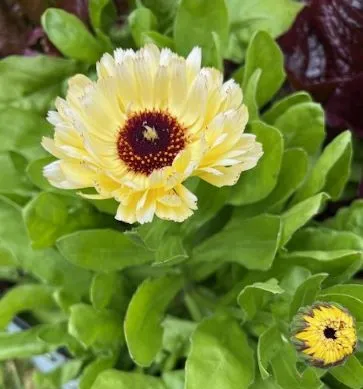
The calendula is a beautiful and hardworking flower in the home garden. It thrives in cool weather, making it a perfect addition to the North Coast. It is in the Asteraceae family and is native to the Mediterranean region.
For home gardeners seeking a plant that is easy to grow, looks beautiful in the garden, is nontoxic to children and animals, and can be used as a cutting flower for most of the year, the Ivory Princess Calendula is a rewarding choice. Calendula is most often recognized as a bright orange and yellow daisy-shaped flower. The bright colors can sometimes be too overpowering for some tastes, but thankfully horticultural breeding has introduced numerous cultivars, including the Ivory Princess Calendula.
After several years growing different varieties of calendula, The Ivory Princess Calendula remains my favorite.
Easy to Grow: Calendula is easy to grow, and Ivory Princess is a very healthy cultivar-showing very minimal powdery mildew, including growing just 6 blocks from the beach, where the coastal marine fog happens daily. Calendula is incredibly forgiving, thriving in a variety of soils and tolerating the cool coastal weather. It has large C-shaped seeds, perfect for direct sowing in spring or fall.
Excellent Cut Flower: It is a great cut flower with delicate, lighter tones than the classic calendula. It makes a cheerful addition to backyard bouquets, and it also lends itself to landscape plantings that pair well with this color scheme. From late spring through fall (and often into winter in milder climates like in Crescent City), calendula continuously produces its charming, daisy-like flowers.
Loved by Pollinators: Calendula’s daisy shape is loved by pollinators. Bees, butterflies, and other pollinators are drawn to calendula's bright blooms, making it an excellent choice for supporting local ecosystems and boosting fruit and vegetable production in your garden.
Instructions for Optimal Growth:
Achieving success with calendula is very straightforward, making it an excellent choice for both beginner and experienced gardeners.
Light Requirements: Calendula can thrive in full sun or part shade.
Sowing: Seeds can be direct sewn in spring after the last frost, or indoors 6 to 8 weeks before the last frost. If starting indoors, avoid high temperatures and light. Light inhibits germination, and high temperatures will produce weak plants. Plant seeds about 1/4 to 1/2 inch deep and 6-12 inches apart. They germinate quickly, often within a week.
Care: Calendula is relatively low-maintenance. Water regularly until established, then it's fairly drought-tolerant, though consistent moisture promotes better flowering. Deadhead spent blooms frequently to encourage both new blooms and a bushier plant. It can pause blooming during a hot summer-cut the plant back severely, and it will bounce back.
For a truly rewarding addition to the home garden, consider the Ivory Princess Calendula. Its easy cultivation ensures that gardeners of all skill levels will enjoy a consistent, cheerful display of blooms throughout most of the year. Calendula plays a vital role in garden health by actively attracting essential pollinators and beneficial insects. These beneficial flowers can be harvested and dried for comforting teas and soothing salves. This outstanding combination of beauty, utility, and resilience makes calendula an exceptional choice for home gardeners on the coast.
Resources
“Calendula" UC Marin Master Gardeners, https://ucanr.edu/site/uc-marin-master-gardeners/documents/calendula.
“Calendula” Cornell University, http://www.gardening.cornell.edu/homegardening/sceneff01.html.
“Year of the Calendula: Beyond Beauty in Your Garden” University of Minnesota Extension, https://extension.umn.edu/yard-and-garden-news/year-calendula.
Article written by Irene McAleenan, First Year Master Gardener

